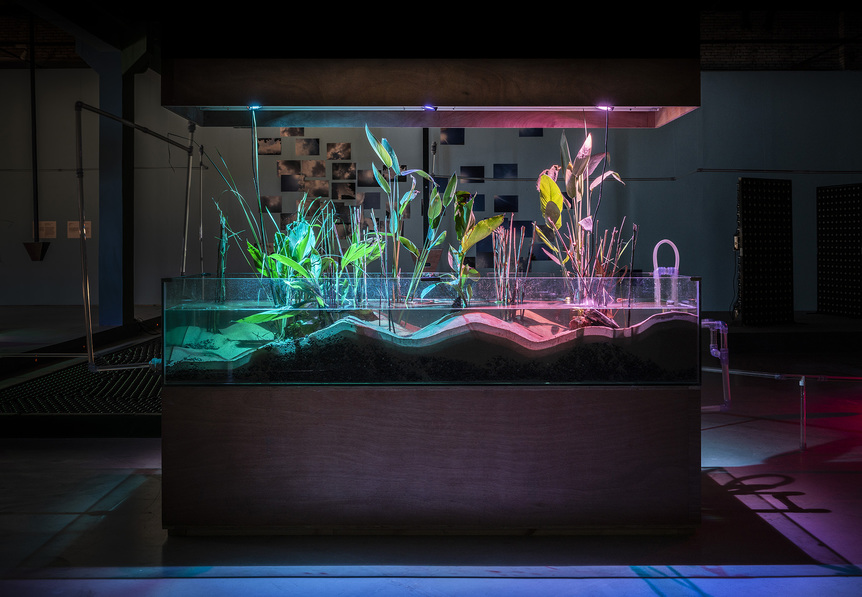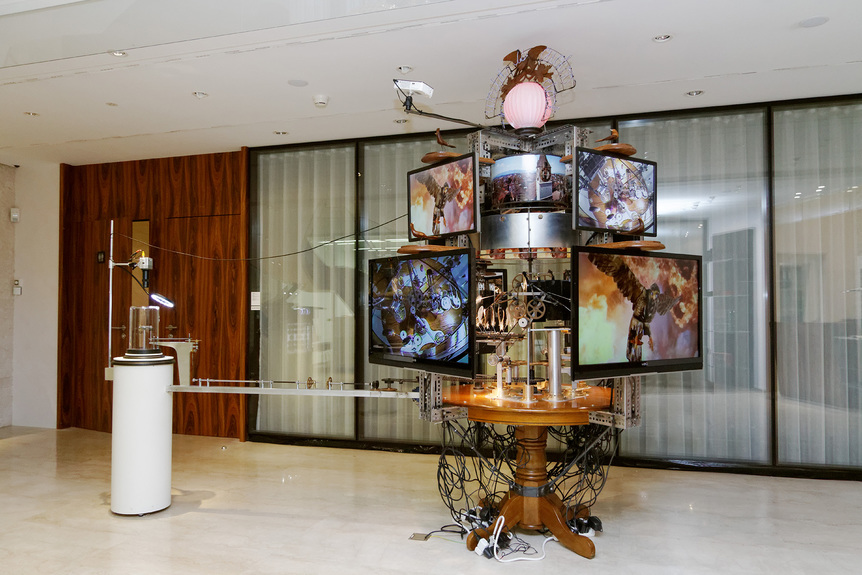-
From Current Issue
-
- Editor’s Letter Fire in the Heart
- Reviews I Gusti Ayu Kadek Murniasih
- Reviews 11th Seoul Mediacity Biennale: “One Escape at a Time”
- Dispatch Networked China
- One on One Monira Al Qadiri on Yukio Mishima
- Essays The rise of independent art spaces in pandemic-era Shanghai
- Features Tuan Andrew Nguyen
- Table of Contents
- Web Exclusives
- Archive
- Subscribe

R
E
V N
E
X
T
Installation view of GILBERTO ESPARZA’s Plantas Autofotosintéticas (Phytonucleum electricus cella), 2015, polycarbonate, stainless steel, electronic circuits, wood, silicone, graphite, silica, sand, activated carbon and acrylic, 2 m × 5 m × 5 m, at the 6th Guangzhou Triennial, “As We May Think: Feedforward,” Guangdong Museum of Art, 2018–19. All images courtesy the Guangdong Museum of Art, Guangzhou.
The 6th Guangzhou Triennial, held at the Guangdong Museum of Art, is titled “As We May Think: Feedforward.” Its chief director Wang Shaoqiang makes a case that the event is the culmination of scattered circumstances. In his introductory text, he invokes the polymathic life of Leonardo Da Vinci, humanity’s natural tendency to adopt technology to make our lives easier, the birth of Bauhaus, the 1919 New Culture Movement of China, the Pearl River Delta’s rise as the world’s manufacturing hub, and more to weave the tapestry of a “grand historical backdrop” for the exhibition.
The artworks of “Feedforward”—curated by Angelique Spaninks, Zhang Ga and Philipp Ziegler—are digital, biological and machinic, and were organized as a body to formulate “speculations that encapsulate the world” and “grasp a fleeting future.” But for a show that is meant to look ahead in human development, the Guangzhou Triennial had a very short shelf life, and at some points resembled an overelaborate science fair. The event didn’t so much explore new ideas as rehash concepts that have been investigated and explained fully (or nearly so) in the past, giving off the impression that it was a few years late to the party.
Despite the dated presentation and unresolved hardware problems in the museum, there were a few interesting artworks. A version of Tega Brain’s installation Deep Swamp (2018) was mounted for the show, where two pieces of software, Hans and Harrison, control lights, water supply, fog and nutrients to shape the growth of wetland plants, adjusting each quality once every few minutes. The programs had been “trained” by being exposed to thousands of tagged images, and then given different goals. Hans aims to produce a work of art, while Harrison wants to cultivate a natural-looking ecosystem. Deep Swamp offers rapidly observable outcomes of simplified environmental engineering, sparking questions about who or what is supposed to benefit from this sort of technological intervention as ecological integrity declines.
Taking up their own room, Thomas Feuerstein’s series of connected artworks were packaged with the aesthetics expected from an anarchic mad scientist’s lair. In the elaborate chemistry experiment, bacteria consume iron and sulfur to generate sulfuric acid, which dissolves the marble of a replica of Nicolas Sébastien Adam’s 1762 sculpture Prometheus Bound, forming two things—gypsum that slowly accumulates in a new sculpture shaped like a stalactite, and a different kind of bacteria that ferments, creating glucose and proteins to generate a liver cell structure. The process turns stone into organic matter, blithely upending the mythological Titan’s fate and challenging us to rethink the definition of biological life.
Brain and Feuerstein’s creations tapped into concerns that resonated beyond the duration of the viewing experience, though many of the other artworks were off mark. Simon Denny’s customized version of the board game Settlers of Catan critiques digital capitalism and the existential paradoxes of tech firm founders, but didn’t link up with the rest of the show in a way that allowed its playfulness to sink in. Visitors were “invited” to navigate Yang Jian’s installation of junk and motion sensors without setting off loud buzzing alarms, but attempts to do so only drew stern security guards. Liu Wa’s interactive installation Glimpse: A Grain of Truth (2018) incorporates lights that are supposed to alter color based on changes in viewers’ brain waves, and hence reveal different elements in a mural, but the apparatus would at times shift hues even when nobody was wearing the electroencephalogram headset. Wang Yuyang’s lifelike silicone mouth that spits at passersby just felt like a prank, with yells of “Ah!” signaling new victims being claimed.
Circling back, what exactly did “Feedforward” say about our world and its “fleeting future”? It didn’t offer a single answer, and instead spammed us with scattered information grouped together under dubious circumstances. Perhaps Jon Kessler’s contribution to the show encapsulates it best: The setup of The World is Cuckoo (Clock) (2016) leads us to believe that a Panerai tourbillon movement drives the kinetic sculpture’s clockwork, but that is a hoax. Complex machinations usually don’t just have a single, tiny heart. Besides, gears prompt visitors to think about how, not why. When it comes to speculations of the future, maybe we just aren’t sure which questions are the right ones to ask.
Brady Ng is the Guangzhou desk editor of ArtAsiaPacific.
The 6th Guangzhou Triennial, “As We May Think: Feedforward,” is on view at the Guangdong Museum of Art until March 10, 2019.
To read more ofArtAsiaPacific’s articles, visit our Digital Library.











